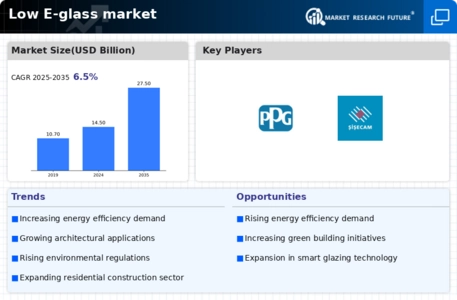Top Industry Leaders in the Low E Glass Market

Low-e glass, a marvel of modern engineering, has revolutionized building design by offering superior energy efficiency and thermal insulation. Its ability to reflect infrared radiation while allowing visible light through keeps buildings cooler in summer and warmer in winter, drastically reducing energy consumption and greenhouse gas emissions. As the world embraces sustainability and energy-efficient solutions. This burgeoning market presents a dynamic competitive landscape, where established giants and emerging players battle for dominance.
Market Leaders and Strategies:
The low-e glass market is dominated by a handful of established players, each with distinct strategies:
-
PPG Industries: A global leader, PPG focuses on innovation and high-performance products. Its flagship Starphire® low-e glass boasts exceptional clarity and thermal performance. -
Guardian Industries: Guardian prioritizes sustainability and environmental responsibility. Their innovative EcoGuard® low-e coating is manufactured with recycled materials and offers excellent energy savings. -
Saint-Gobain: This French giant emphasizes regional expansion and caters to diverse market needs. Their COOL-LITE® range offers a variety of low-e options for different climates and applications. -
Asahi Glass: The Japanese powerhouse focuses on technological advancements and developing cutting-edge solutions. Their Low-E Pilkington NSG® series features advanced coatings for superior thermal insulation and solar control.
Factors Influencing Market Share:
Several factors influence market share in this dynamic landscape:
-
Product Portfolio and Innovation: Companies offering a diverse range of low-e coatings with varying performance levels and price points cater to a wider customer base. Continuous innovation in coating technology and functionalities like self-cleaning or switchable glass can be a game-changer. -
Geographical Presence and Distribution Network: Strong regional presence and a robust distribution network ensure timely delivery and market reach. Expanding into emerging markets with high growth potential like Asia-Pacific can be a strategic advantage. -
Cost-Competitiveness and Production Efficiency: Optimizing production processes and maintaining competitive pricing are crucial for attracting budget-conscious customers. Balancing cost-effectiveness with quality and performance is key. -
Sustainability and Environmental Credentials: With growing environmental awareness, companies with strong sustainability practices and eco-friendly product offerings gain favor. Highlighting recycled content, reduced energy consumption in production, and lifecycle assessments can attract environmentally conscious consumers. -
Government Regulations and Incentives: Stringent energy efficiency regulations in various countries mandate the use of low-e glass in new buildings, creating a significant market opportunity. Government incentives for energy-efficient solutions further boost demand.
Key Companies in the Low E-glass market include
-
Asahi Glass Co. Ltd.
-
Saint-Gobain SA
-
Corning Inc.
-
Nippon Sheet Glass Co. Ltd.
-
Xinyi Glass Holdings Limited
-
PPG Industries, Inc.
-
CSG Holding Co. Ltd.
-
Taiwan Glass Industry Corporation
-
China Glass Holdings Limited
-
Sisecam.
Recent Developments:
September 2023: Asahi Glass announces plans to invest $1 billion in expanding its low-e glass production capacity in Southeast Asia, anticipating rapid growth in the region.
October 2023: PPG Industries collaborates with a research institute to develop a new low-e coating with enhanced self-cleaning properties, aiming to reduce maintenance costs for building owners.
November 2023: Saint-Gobain launches a digital platform for architects and builders to easily select and specify the right COOL-LITE® low-e glass for their projects.

